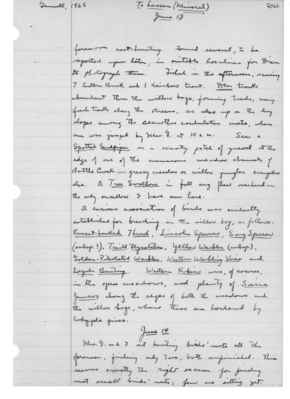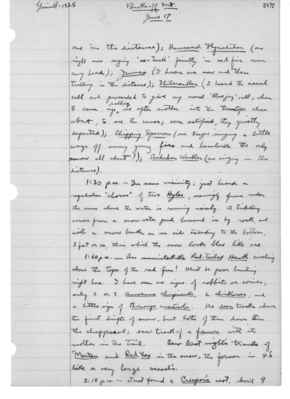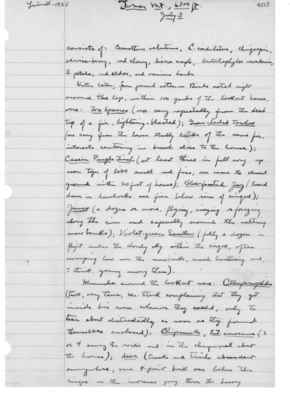Pages That Mention deer
1925: Joseph Grinnell's field notes
S2 Page 6
Collector: Grinnell - 1925 Location: Lassen Section (Mineral) Date: June 13-14, 1925 Page Number: 2462
forenoon nest-hunting. Found several, to be reported upon later, in suitable locations for Dixon to photograph them. Fished in the afternoon, securing 7 Eastern Brook and 1 Rainbow Trout. Deer tracks abundant thru the willow bogs, forming trails; many fresh tracks along the streams, as also up on the dry slopes among the Ceanothus cordulatus mats, where one was jumped by Mrs. G at 10 a.m. Saw a Spotted Sandpiper on a scanty patch of gravel at the edge of one of the numerous meadow channels of Battle Creek - grassy meadows on willow jungles everywhere else. A Tree Swallow in full song flew overhead - the only swallow I have seen here. A curious association of birds was evidently established for birding in the willow bog, as follows: Russet-backed Thrush, Lincoln Sparrow, Song Sparrow (subsp.?), Traill Flycatcher, Yellow Warbler (subsp.), Golden-Pileolated Warbler, Western Warbling Vireo and Lazuli Bunting. Western Robins were, of course, in the open meadows, and plenty of Sierra Juncos along the edges of both the meadows and the willow bogs, where these are bordered by lodgepole pines. June 14 Mrs. G. and I out hunting birds' nests all the forenoon, finding only two, both unfinished. This seems exactly the right season for finding most small birds' nests; few are sitting yet.
S2 Page 17
Collector: Grinnell - 1925 Location: Lassen Section (Brokeoff Mt.) Date: June 17, 1925 Page Number: 2472
one in the distance); Hammond Flycatcher (one right now saying "see-Tuck" faintly in red fir over my head); Junco (I hear one now and then trilling in the distance); Nutcracker (I heard the nasal call and proceeded to give my usual "bluejay" call, when 5 came up, calling, one after another into the treetops close about, to see the cause; soon satisfied, they quietly departed); Chipping Sparrow (one keeps singing a little way off away young firs and hemlocks the only snow all about!); Audubon Warbler (one singing in the distance). 1:30 p.m. - In same vicinity; just heard a regulation "chorus" of two Hylas, seemingly from under the snow where the water is running noisily. A tributary comes from a snow-water pond hemmed in by rock, and with a snow bank on one side extending to the bottom, 3 feet or so, thru which the snow looks blue like ice. 1:50 p.m. - An unmistakable Red-Tailed Hawk circling above the tops of the red firs! Must be poor hunting right here. I have seen no signs of rabbits or conies; only 2 or 3 Amoenus Chipmunk, 2 chickadees, and a little sign of Thomomys monticola. No deer tracks above the first drifts of snow, but lots of them down thru the chaparral; saw track of a fawn with its mother in the trail. Saw last night's tracks of Marten and Red Fox in the snow, the former in 4's like a very large weasel's. 2:15 p.m. - Just found a Creeper's nest, about 9
S2 Page 55
Collector: Grinnell - 1925 Location: Mineral Date: June 28 Page Number: 2508
poising, motionless, at times against the stiff west wind. Mrs. G. found a family of Golden crowned Kinglets in a group of young firs near camp - adults and 4 young, fully grown. I had a clear view of the two of the young - white line over eye, contrasted against dusky or blackish top of head.
June 29 8 a.m. - Traill Flycatcher's nest: in bog, chiefly grown to willow, but some white alder; located out in jungle, alongside of indistinct deer-trail; overtopped, well shaded, by lush green willow and older foliage; rim 1400 mm. above ground, nest insse^securely supported among cluster of upright small willow stems and emanating leaves. Taken (2/4)*, and [female symbol] parent shot.
Russet-backed Thrushes' nest: in same bog as last; rim 780 mm. above ground; situated in rather low willow clump, with larger (taller) clumps of willow and white alder about separated from one another by openings grown to lush grass and buttercup; a meadow stream runs 20 feet away. The green leafage above and all about the nest effectually conceals the nest until parted. The nest is supported on a slanting willow stem plus adjacent twigs and foliage. Taken (1/4)**, and [female symbol] parent taken; [male symbol] heard singing in vicinity mornings and evenings ever since we have been here. Mrs. G. found this nest. The site is almost directly between those of the two
S2 Page 64
Collector: Grinnell - 1925 Location: Turner Mt., 6300 ft. Date: July 3 Page Number: 2517
consist of: Ceanothus velutinus, C. cordulatus, chinquapin, service-berry, red cherry, Sierra maple, Arctostaphylos nevadensis, A. patula, red alder, and various herbs.
Written later, from pencil notes. - Birds noted right around the top, within 100 yards of the lookout house, were: Fox Sparrow (one sang repeatedly from the dead tip of a fir, lightning-blasted); Green-tailed Towhee (one sang from the lower stubby limbs of the same fir, interests centering in the brush close to the house); Cassin Purple Finch (at least three in full song up near tops of live small red firs, one came to cleared ground within 20 feet of house); Blue-fronted Jay (heard down in the hemlocks and firs below rim of cirque); Junco (a dozen or more, flying, singing or foraging along the rim and especially around the melting snow banks); Violet-green Swallow (fully a dozen in flight under the cloudy sky within the cirque, often swooping low over the snowbanks, much twittering and, I think, young among them.
Mammals around the lookout were: Callospermophilus (two, very tame, Mr. Stark complaining that they got inside his room whenever they could, only to tear about distractedly as soon a they found themselves enclosed), Chipmunks, Eut. amoenus (3 or 4 among the rocks and in the chaparral about the house); deer (tracks and tails abundant everywhere, one 4-point buck seen below the cirque on the moraines going thru [sic] the heavy
S2 Page 77
Collector: Grinnell - 1925 Location: Mineral, 4800 ft. Date: July 26 Page Number: 2530
of the nest she has under observation - Robin ^(2 eggs), Wright Flycatcher ^(3 eggs), Green-tailed Towhee (3 small young). She is keeping full, formal notes on all these, so I won't repeat. The most astonishing thing is the second set of eggs of Wright Flycatcher in the same nest a brood of 4 was raised in, this season. As far as I can see, the nest is in excellent condition, clean and compact; of course is might have - probably was - re lined and otherwise renovated at the beginning of the second mating.
Jumped a fawn here by camp, from a lying-down place under a very small fir surrounded by dense ceanothus cordulatus save for a poorly marked entrance gangway. The deer somehow got thru [sic] the mass of entanglements opposite me as I came in along the "gangway"; I noted mentally that it was a "jack rabbit" until it bounded into the open beyond, behaving, in movements, just like an old deer, tho it certainly wasn't more than 1/4 grown.
6293 Calaveras Warbler [male symbol] im. 8.1g. Shot out of hemlock, 25 feet up, where looked much larger than it proved to be.
6294 Sierra Crossbill [male symbol] ad. 29.6g. Shot out of top of hemlock about 25 feet above steeply sloping mountain-side. Testes [testes illustration]. With at least 5 others scattered about in tops of closely adjacent hemlocks, these latter abundantly producing the green pendant cones. I was mentally sure the crossbills were feeding on these cones; if even when skinning the bird shot, and I




